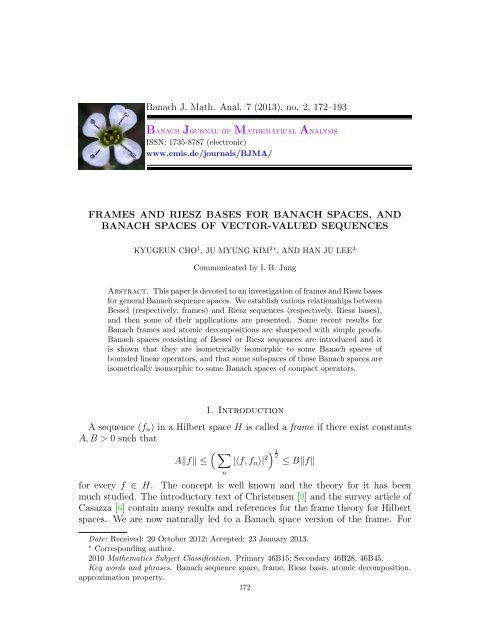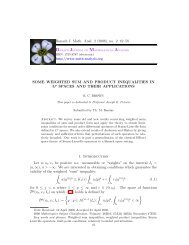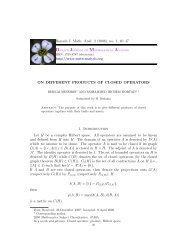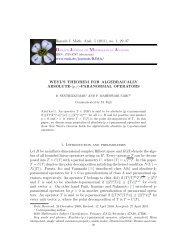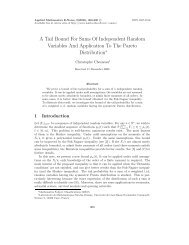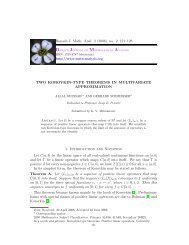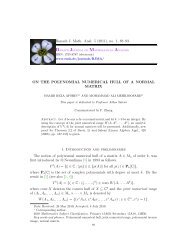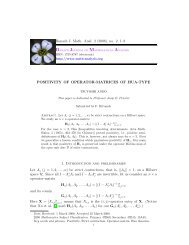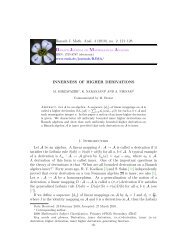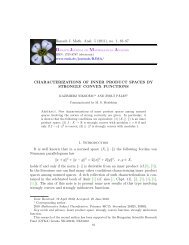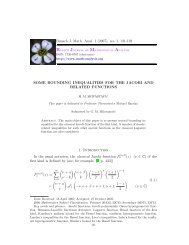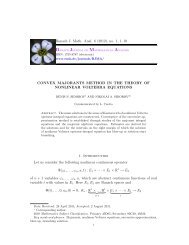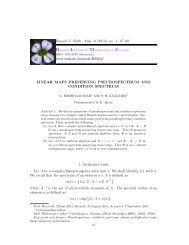Frames and Riesz bases for Banach spaces, and Banach spaces of ...
Frames and Riesz bases for Banach spaces, and Banach spaces of ...
Frames and Riesz bases for Banach spaces, and Banach spaces of ...
- No tags were found...
You also want an ePaper? Increase the reach of your titles
YUMPU automatically turns print PDFs into web optimized ePapers that Google loves.
<strong>Banach</strong> J. Math. Anal. 7 (2013), no. 2, 172–193<strong>Banach</strong> Journal <strong>of</strong> Mathematical AnalysisISSN: 1735-8787 (electronic)www.emis.de/journals/BJMA/FRAMES AND RIESZ BASES FOR BANACH SPACES, ANDBANACH SPACES OF VECTOR-VALUED SEQUENCESKYUGEUN CHO 1 , JU MYUNG KIM 2∗ , AND HAN JU LEE 3Communicated by I. B. JungAbstract. This paper is devoted to an investigation <strong>of</strong> frames <strong>and</strong> <strong>Riesz</strong> <strong>bases</strong><strong>for</strong> general <strong>Banach</strong> sequence <strong>spaces</strong>. We establish various relationships betweenBessel (respectively, frames) <strong>and</strong> <strong>Riesz</strong> sequences (respectively, <strong>Riesz</strong> <strong>bases</strong>),<strong>and</strong> then some <strong>of</strong> their applications are presented. Some recent results <strong>for</strong><strong>Banach</strong> frames <strong>and</strong> atomic decompositions are sharpened with simple pro<strong>of</strong>s.<strong>Banach</strong> <strong>spaces</strong> consisting <strong>of</strong> Bessel or <strong>Riesz</strong> sequences are introduced <strong>and</strong> itis shown that they are isometrically isomorphic to some <strong>Banach</strong> <strong>spaces</strong> <strong>of</strong>bounded linear operators, <strong>and</strong> that some sub<strong>spaces</strong> <strong>of</strong> those <strong>Banach</strong> <strong>spaces</strong> areisometrically isomorphic to some <strong>Banach</strong> <strong>spaces</strong> <strong>of</strong> compact operators.1. IntroductionA sequence (f n ) in a Hilbert space H is called a frame if there exist constantsA, B > 0 such that( ∑ ) 1A‖f‖ ≤ |〈f, f n 〉| 2 2≤ B‖f‖n<strong>for</strong> every f ∈ H. The concept is well known <strong>and</strong> the theory <strong>for</strong> it has beenmuch studied. The introductory text <strong>of</strong> Christensen [9] <strong>and</strong> the survey article <strong>of</strong>Casazza [6] contain many results <strong>and</strong> references <strong>for</strong> the frame theory <strong>for</strong> Hilbert<strong>spaces</strong>. We are now naturally led to a <strong>Banach</strong> space version <strong>of</strong> the frame. ForDate: Received: 20 October 2012; Accepted: 23 January 2013.∗ Corresponding author.2010 Mathematics Subject Classification. Primary 46B15; Secondary 46B28, 46B45.Key words <strong>and</strong> phrases. <strong>Banach</strong> sequence space, frame, <strong>Riesz</strong> basis, atomic decomposition,approximation property.172
FRAMES AND RIESZ BASES FOR BANACH SPACES 1731 ≤ p ≤ ∞, a sequence (x ∗ n) in the dual space X ∗ <strong>of</strong> a <strong>Banach</strong> space X is calleda p-frame <strong>for</strong> X if there exist constants A, B > 0 such that( ∑ ) 1A‖x‖ ≤ |x ∗ n(x)| p p≤ B‖x‖n<strong>for</strong> every x ∈ X. For the case p = ∞, ( ∑ n |x∗ n(x)| p ) 1 p is replaced by supn |x ∗ n(x)|.If there exists a 2-frame <strong>for</strong> a <strong>Banach</strong> space, then the <strong>Banach</strong> space is isomorphicto a Hilbert space. The concept was introduced by Aldroubi, Sun <strong>and</strong> Tang [2]<strong>and</strong> some abstract theories <strong>for</strong> it were studied by Christensen <strong>and</strong> Stoeva [11, 19].Casazza, Christensen <strong>and</strong> Stoeva [7] introduced <strong>and</strong> studied a more generalnotion. They defined that a sequence (x ∗ n) in X ∗ is a B s -frame <strong>for</strong> X, where B sis a scalar-valued <strong>Banach</strong> sequence space that is a linear space <strong>of</strong> sequences witha norm which makes it a <strong>Banach</strong> space <strong>and</strong> <strong>for</strong> which the coordinate functionalsare continuous, if(i) (x ∗ n(x)) ∈ B s <strong>for</strong> every x ∈ X,(ii) there exist constants A, B > 0 such thatA‖x‖ ≤ ‖(x ∗ n(x))‖ Bs ≤ B‖x‖<strong>for</strong> every x ∈ X. An l p -frame <strong>for</strong> a <strong>Banach</strong> space is exactly a p-frame. We saythat (x ∗ n) is a B s -Bessel sequence <strong>for</strong> X if (i) <strong>and</strong> the upper B s -frame conditionare satisfied. Since a <strong>Banach</strong> space X can be identified with a subspace <strong>of</strong> thebidual space X ∗∗ <strong>of</strong> X, <strong>for</strong> a given sequence in X, the B s -Bessel sequence (resp.frame) <strong>for</strong> X ∗ can be analogously defined.For a sequence (x ∗ n) in X ∗ (resp. (x n ) in X), if the mapF (x ∗ n ) : X → B s , x ↦→ (x ∗ n(x))(resp. F (xn) : X ∗ → B s , x ∗ ↦→ (x ∗ (x n )))is well defined, then from the closed graph theorem it is automatically bounded.This means that the condition <strong>of</strong> B s -Bessel sequence is only (i) in the frameconditions. The operator is called the analysis operator. A sequence is a B s -frame if <strong>and</strong> only if the analysis operator is an isomorphism.Considering the classical <strong>Banach</strong> sequence <strong>spaces</strong> l p (1 ≤ p ≤ ∞) <strong>and</strong> c 0 , thenan l p (1 ≤ p < ∞) (resp. c 0 )-Bessel sequence (x n ) <strong>for</strong> X ∗ is a weakly p-summable(resp. null) sequence, an l ∞ -Bessel sequence (x n ) <strong>for</strong> X ∗ is a bounded sequence,<strong>and</strong> <strong>for</strong> a sequence (x ∗ n) in X ∗ , a c 0 -Bessel sequence (x ∗ n) <strong>for</strong> X is a weak ∗ nullsequence.We say that a sequence (x n ) in X is a B s -<strong>Riesz</strong> basic sequence <strong>for</strong> X if(i) ∑ n α nx n converges <strong>for</strong> every (α n ) ∈ B s ,(ii) there exist constants A, B > 0 such thatA‖(α n )‖ Bs ≤ ∥ ∑ ∥ ∥∥α n x n ≤ B‖(αn )‖ Bsn<strong>for</strong> every (α n ) ∈ B s .In particular, a B s -<strong>Riesz</strong> basic sequence (x n ) <strong>for</strong> X is a B s -<strong>Riesz</strong> basis if X =span{x n } <strong>and</strong> in this paper we call (x n ) a B s -<strong>Riesz</strong> sequence <strong>for</strong> X if (i) is satisfied.
174 K. CHO, J.M. KIM, H.J. LEENote that (x n ) is an l ∞ -<strong>Riesz</strong> sequence <strong>for</strong> X if <strong>and</strong> only if (x n ) is unconditionallysummable (cf. [17, Theorem 4.2.8]).For a B s -<strong>Riesz</strong> sequence (x n ) <strong>for</strong> X, the synthesis operator is defined byR (xn) : B s → X, (α n ) ↦→ ∑ nα n x n .From the <strong>Banach</strong>-Steinhaus theorem, a sequence is a B s -<strong>Riesz</strong> sequence if <strong>and</strong>only if the synthesis operator is well defined <strong>and</strong> bounded. Also a sequence is aB s -<strong>Riesz</strong> basic sequence if <strong>and</strong> only if the synthesis operator is an isomorphism.The <strong>Riesz</strong> basis <strong>for</strong> a Hilbert space is well known (cf. [6, 9]), <strong>and</strong> in [2, 11], l p -<strong>Riesz</strong><strong>bases</strong> <strong>for</strong> <strong>Banach</strong> <strong>spaces</strong> were introduced <strong>and</strong> studied. This paper is organized asfollows.In Section 2 we establish some relationships between Bessel <strong>and</strong> <strong>Riesz</strong> sequences.It is well known that a sequence (x n ) in X is an l 1 -Bessel sequence<strong>for</strong> X ∗ if <strong>and</strong> only if (x n ) is a c 0 -<strong>Riesz</strong> sequence <strong>for</strong> X (cf. [17, Proposition4.3.9]). Christensen <strong>and</strong> Stoeva [11, Proposition 2.2] showed that a sequence (x ∗ n)in X ∗ is an l p (1 < p < ∞)-Bessel sequence <strong>for</strong> X if <strong>and</strong> only if (x ∗ n) is an l p ∗-<strong>Riesz</strong>sequence <strong>for</strong> X ∗ , where p ∗ = p/(p − 1). We extend those results, more precisely,<strong>for</strong> the dual <strong>Banach</strong> sequence space Y s <strong>of</strong> B s , it is shown that a sequence (x n ) inX (resp. (x ∗ n) in X ∗ ) is a Y s -Bessel sequence <strong>for</strong> X ∗ (resp. X) if <strong>and</strong> only if (x n )(resp. (x ∗ n)) is a B s -<strong>Riesz</strong> sequence <strong>for</strong> X (resp. X ∗ ). Moreover, we establishsome relationships between B s -Bessel <strong>and</strong> Y s -<strong>Riesz</strong> sequences.In Section 3 we study some relationships between B s (resp. Y s )-<strong>Riesz</strong> <strong>bases</strong> <strong>and</strong>Y s (resp. B s )-frames, necessary <strong>and</strong> sufficient conditions <strong>for</strong> Y s (resp. B s )-framesto be B s (resp. Y s )-<strong>Riesz</strong> <strong>bases</strong>.In Section 4 we study <strong>Banach</strong> frames <strong>and</strong> atomic decompositions. Some recentresults [3, 4, 7] <strong>for</strong> them are sharpened with simple pro<strong>of</strong>s.We denote the collection <strong>of</strong> B s -Bessel sequences in X <strong>for</strong> X ∗ (resp. X ∗ <strong>for</strong>X) by Bs w (X) (resp. Bs w∗ (X ∗ )). If B s = l p (1 ≤ p < ∞) (resp. B s = l ∞ ),then Bs w (X) is the collection <strong>of</strong> weakly p-summable (resp. bounded) sequencesin X, <strong>and</strong> c w 0 (X) (resp. c w∗0 (X ∗ )) is the collection <strong>of</strong> weakly (resp. weak ∗ ) nullsequences in X (resp. X ∗ ). We denote the collection <strong>of</strong> B s -<strong>Riesz</strong> sequences inX by B s R(X). These collections are vector <strong>spaces</strong> under the st<strong>and</strong>ard operation<strong>of</strong> scalar multiplication <strong>and</strong> addition <strong>for</strong> sequences. In Section 5 we show thatthese vector <strong>spaces</strong> are <strong>Banach</strong> <strong>spaces</strong> endowed with some norms <strong>and</strong> that theyare isometrically isomorphic to some <strong>Banach</strong> <strong>spaces</strong> <strong>of</strong> bounded linear operators.In Section 6 we introduce the ˇB s -Bessel <strong>and</strong> <strong>Riesz</strong> sequences which are specialBessel <strong>and</strong> <strong>Riesz</strong> sequences. We show that the <strong>Banach</strong> <strong>spaces</strong> consisting <strong>of</strong> themare isometrically isomorphic to some <strong>Banach</strong> <strong>spaces</strong> <strong>of</strong> compact operators. Alsoit is shown that a sequence is a ˇY s -Bessel (resp. ˇBs -Bessel) sequence if <strong>and</strong> onlyif it is a ˇB s -<strong>Riesz</strong> (resp. ˇYs -<strong>Riesz</strong>) sequence.2. Relationships between Bessel <strong>and</strong> <strong>Riesz</strong> sequencesThe purpose <strong>of</strong> this section is to establish some relationships between Bessel<strong>and</strong> <strong>Riesz</strong> sequences. In order to do this, we need the well known representation
FRAMES AND RIESZ BASES FOR BANACH SPACES 175<strong>of</strong> the dual space B ∗ s <strong>of</strong> B s ; cf. [7, Lemma 3.1]. Let (e n ) be the sequence <strong>of</strong> thecanonical unit vectors <strong>and</strong> suppose that (e n ) is a Schauder basis <strong>for</strong> B s . LetY s = {(x ∗ s(e n ))|x ∗ s ∈ B ∗ s}<strong>and</strong> ‖(x ∗ s(e n ))‖ Ys = ‖x ∗ s‖. Then we see that (Y s , ‖ · ‖ Ys ) is a normed space <strong>and</strong>the coordinate functionals <strong>for</strong> Y s are continuous. Consider the map j s : Y s → Bs∗defined by j s [(x ∗ s(e n ))] = x ∗ s. Then j s is a surjective linear isometry <strong>and</strong> so Y s isa <strong>Banach</strong> sequence space. For example, if B s = l p (1 < p < ∞) (resp. l 1 ), thenY s = l p ∗ (resp. l ∞ ), <strong>and</strong> if B s = c 0 , then Y s = l 1 .Now <strong>for</strong> every x ∗ s ∈ Bs ∗ <strong>and</strong> (α n ) ∈ B s( ∑ )x ∗ s((α n )) = x ∗ s α n e n = ∑nnα n x ∗ se n = ∑ nα n (j −1s x ∗ s) n ,where (js−1 x ∗ d ) n is the n-th element <strong>of</strong> js−1 x ∗ d . Let (f n) be the sequence <strong>of</strong> thecanonical unit vectors in Y s . Fix k ∈ N. Then <strong>for</strong> every (α n ) ∈ B sj s f k ((α n )) = ∑ nα n (js−1 j s f k ) n = ∑ nα n (f k ) n = α k .This shows that (j s f n ) is the sequence <strong>of</strong> the coordinate functionals <strong>for</strong> B s . If(f n ) is a Schauder basis <strong>for</strong> Y s , then <strong>for</strong> every x ∗ s ∈ B ∗ s( ∑ )x ∗ s = j s [(x ∗ s(e n ))] = j s x ∗ s(e n )f n = ∑ nnx ∗ s(e n )j s f n .Throughout this paper we use the objects Y s , j s , (e n ), (f n ), the analysis <strong>and</strong>synthesis operators in the introduction. Recall that an operator S from Y ∗ to X ∗is weak ∗ to weak ∗ continuous if <strong>and</strong> only if there exists an operator T from X toY such that S is the adjoint operator T ∗ <strong>of</strong> T ; cf. see [17, Theorem 3.1.11]. Wenow haveTheorem 2.1. Suppose that (e n ) is a Schauder basis <strong>for</strong> B s <strong>and</strong> let (x n ) be asequence in X. Then the following are equivalent.(a) The analysis operator F (xn) : X ∗ → Y s is well defined.(b) The synthesis operator R (xn) : B s → X is well defined.(c) The analysis operator F (xn) : X ∗ → Y s is well defined <strong>and</strong> the operator j s F (xn) :X ∗ → Bs ∗ is weak ∗ to weak ∗ continuous.Hence (x n ) ∈ Ys w (X) if <strong>and</strong> only if (x n ) ∈ B s R(X).Pro<strong>of</strong>. (c)=⇒(a) is trivial.
176 K. CHO, J.M. KIM, H.J. LEE(a)=⇒(b) Recall that F (xn) is bounded. Let (α n ) ∈ B s . Then∥l∑ ∥ ∥∥α n x n =n=msupx ∗ ∈B X ∗∣= sup ∣x ∗ ∈B X ∗l∑α n x ∗ (x n ) ∣n=ml∑α n j s [(x ∗ (x k ))](e n ) ∣n=m(∣l∑ )∣= sup ∣j s [(x ∗ ∣∣(x k ))] α n e nx ∗ ∈B X ∗n=m∥≤ sup ‖j s [(x ∗ ∥∥l∑ ∥ ∥∥Bs(x k ))]‖ B ∗ sα n e nx ∗ ∈B X ∗n=m∥= sup ‖(x ∗ ∥∥l∑ ∥ ∥∥Bs(x k ))‖ Ys α n e nx ∗ ∈B X ∗n=m l∑ ∥ ∥∥Bs= ‖F (xn)‖ ∥ α n e n −→ 0 as l, m → ∞.n=mHence ∑ n α nx n converges.(b)=⇒(c) Recall that R (xn) is bounded. Consider the operator js−1 R(x ∗ : n) X∗ →Y s . Then <strong>for</strong> every x ∗ ∈ X ∗(x ∗ (x n )) = (x ∗ (R (xn)e n )) = ((R ∗ (x n)x ∗ )e n ) = j −1s R ∗ (x n)x ∗ ∈ Y s .Hence F (xn) is well defined, F (xn) = js−1 R(x ∗ <strong>and</strong> so j n) sF (xn) = R(x ∗ is n) weak∗ toweak ∗ continuous.□For example, <strong>for</strong> 1 < p < ∞, (x n ) ∈ l p R(X) if <strong>and</strong> only if (x n ) ∈ l w p ∗(X),(x n ) ∈ l 1 R(X) if <strong>and</strong> only if (x n ) ∈ l ∞ (X), <strong>and</strong> (x n ) ∈ c 0 R(X) if <strong>and</strong> only if(x n ) ∈ l w 1 (X). For every <strong>Banach</strong> space X, let (x n ) be a bounded sequence in X,which does not weakly converge to 0. Then (x n ) ∈ l 1 R(X) but (x n ) ∉ c w 0 (X).Remark 2.2. For every <strong>Banach</strong> space X containing c 0 there exists a (x n ) ∈ l w 1 (X)such that (x n ) ∉ l ∞ R(X) because a <strong>Banach</strong> space X does not contain c 0 if <strong>and</strong>only if every weakly summable sequence in X is unconditionally summable; see[14, (I.4.5)] or [17, Theorem 4.3.12].We have the following duality result <strong>of</strong> Theorem 2.1.Corollary 2.3. Suppose that (e n ) is a Schauder basis <strong>for</strong> B s <strong>and</strong> let (x ∗ n) be asequence in X ∗ . Then the following are equivalent.(a) The analysis operator F (x ∗ n ) : X → Y s is well defined.(b) The synthesis operator R (x ∗ n ) : B s → X ∗ is well defined.(c) The analysis operator F (x ∗ n ) : X ∗∗ → Y s is well defined <strong>and</strong> the operator j s F (x ∗ n ) :X ∗∗ → Bs ∗ is weak ∗ to weak ∗ continuous.Hence (x ∗ n) ∈ Ysw∗ (X ∗ ) if <strong>and</strong> only if (x ∗ n) ∈ B s R(X ∗ ) if <strong>and</strong> only if (x ∗ n) ∈Ys w (X ∗ ).
FRAMES AND RIESZ BASES FOR BANACH SPACES 177Pro<strong>of</strong>. (c)=⇒(a) is clear <strong>and</strong> (b)=⇒(c) follows from Theorem 2.1(b)=⇒(c).(a)=⇒(b) Since <strong>for</strong> every (α n ) ∈ B sl∑∣∥ α n x ∗ ∣∣l∑∣n∥ = sup α n x ∗ ∣∣l∑n(x) ∣ = sup α n j s [(x ∗ ∣k(x))](e n ) ∣,x∈B X x∈B Xn=mn=mn=mfrom the pro<strong>of</strong> <strong>of</strong> Theorem 2.1(a)=⇒(b) the conclusion follows.Interchanging the dual <strong>Banach</strong> sequence space Y s with B s , we have the followingsymmetric version <strong>of</strong> Theorem 2.1.Theorem 2.4. Suppose that (e n ) is a Schauder basis <strong>for</strong> B s <strong>and</strong> (f n ) is a Schauderbasis <strong>for</strong> Y s <strong>and</strong> let (x n ) be a sequence in X. Then the following are equivalent.(a) The analysis operator F (xn) : X ∗ → B s is well defined.(b) The synthesis operator R (xn) : Y s → X ∗∗ is well defined <strong>and</strong> the operatorR (xn)js−1 : Bs ∗ → X ∗∗ is weak ∗ to weak continuous.(c) The analysis operator F (xn) : X ∗ → B s is well defined <strong>and</strong> weak ∗ to weakcontinuous.Pro<strong>of</strong>. (c)=⇒(a) is trivial.(a)=⇒(b) Consider the operator F ∗ (x n) j s : Y s → X ∗∗ . Then <strong>for</strong> every n <strong>and</strong>x ∗ ∈ X ∗ (F ∗ (x n)j s f n )x ∗ = j s f n F (xn)x ∗ = j s f n [(x ∗ (x k ))] = x ∗ (x n )□<strong>and</strong> so F(x ∗ j n) sf n = x n <strong>for</strong> every n. Now <strong>for</strong> every (β n ) ∈ Y s( ∑ )F(x ∗ n)j s ((β n )) = F(x ∗ n)j s β n f n = ∑ β n F(x ∗ n)j s f n = ∑nnnβ n x n .Hence R (xn) = F(x ∗ j n) s is well defined <strong>and</strong> R (xn)js−1 = F(x ∗ is n) weak∗ to weakcontinuous because R (xn)(Y s ) ⊂ X.(b)=⇒(c) By the assumption there exists an operator T : X ∗ → B s such thatT ∗ = R (xn)js−1 . But <strong>for</strong> every x ∗ ∈ X ∗T x ∗ = (j s f n T x ∗ ) = ((T ∗ j s f n )x ∗ ) = (R (xn)f n x ∗ ) = (x ∗ (x n )).Hence F (xn) = T is well defined <strong>and</strong> weak ∗ to weak continuous because F ∗ (x n) (B∗ s) =R (xn)j −1s (B ∗ s) ⊂ X. □From Theorem 2.4, if (x n ) ∈ B w s (X), then (x n ) ∈ Y s R(X), <strong>and</strong> the conversedoes not hold in general by Remark 2.2 above, but if B s is reflexive, then theconverse is true.Remark 2.5. The assumption that (f n ) is a Schauder basis <strong>for</strong> Y s is not usedin the pro<strong>of</strong> <strong>of</strong> Theorem 2.4(b)=⇒(c), but (a)=⇒(b) need the assumption (seeRemark 2.2).From the same argument as in the pro<strong>of</strong> <strong>of</strong> Theorem 2.4, we have the followingduality result.Corollary 2.6. Suppose that (e n ) is a Schauder basis <strong>for</strong> B s <strong>and</strong> (f n ) is aSchauder basis <strong>for</strong> Y s <strong>and</strong> let (x ∗ n) be a sequence in X ∗ . Then the followingare equivalent.
178 K. CHO, J.M. KIM, H.J. LEE(a) The analysis operator F (x ∗ n ) : X → B s is well defined.(b) The synthesis operator R (x ∗ n ) : Y s → X ∗ is well defined <strong>and</strong> the operatorR (x ∗ n )js−1 : Bs ∗ → X ∗ is weak ∗ to weak ∗ continuous.3. B s -<strong>Frames</strong> <strong>and</strong> <strong>Riesz</strong> <strong>bases</strong>In this section we use the results in Section 2 to establish some relationshipsbetween frames <strong>and</strong> <strong>Riesz</strong> <strong>bases</strong>, necessary <strong>and</strong> sufficient conditions <strong>for</strong> frames tobe <strong>Riesz</strong> <strong>bases</strong>.Recall that an operator T is surjective if <strong>and</strong> only if T ∗ is an isomorphism,<strong>and</strong> T ∗ is surjective if <strong>and</strong> only if T is an isomorphism; cf. [17, Theorem 3.1.22].Then we haveTheorem 3.1. Suppose that (e n ) is a Schauder basis <strong>for</strong> B s <strong>and</strong> let (x n ) be asequence in X. Then the following are equivalent.(a) The analysis operator F (xn) : X ∗ → Y s is an isomorphism.(b) The synthesis operator R (xn) : B s → X is surjective.(c) The analysis operator F (xn) : X ∗ → Y s is an isomorphism <strong>and</strong> the operatorj s F (xn) : X ∗ → B ∗ s is weak ∗ to weak ∗ continuous.Pro<strong>of</strong>. (c)=⇒(a) is trivial.(a)=⇒(b) By Theorem 2.1 R (xn) is well defined. Then R ∗ (x n) = j sF (xn) in thepro<strong>of</strong> <strong>of</strong> Theorem 2.1(b)=⇒(c). Hence by the assumption (a) R (xn) is surjective.(b)=⇒(c) Since R ∗ (x n) = j sF (xn), by the assumption (b) F (xn) is an isomorphism.□From Theorem 3.1, if (x n ) is a B s -<strong>Riesz</strong> basis <strong>for</strong> X, then (x n ) is a Y s -frame<strong>for</strong> X ∗ . For example, if (x n ) is an l p -<strong>Riesz</strong> basis <strong>for</strong> X (1 ≤ p < ∞), then (x n ) isan l p ∗-frame <strong>for</strong> X ∗ , <strong>and</strong> if (x n ) is a c 0 -<strong>Riesz</strong> basis <strong>for</strong> X, then (x n ) is an l 1 -frame<strong>for</strong> X ∗ . But a Y s -frame <strong>for</strong> X ∗ does not imply a B s -<strong>Riesz</strong> basis <strong>for</strong> X in general.Indeed, consider the sequence (x n ) = (e 1 , 0, e 2 , 0, · · ·, 0, e n , 0, · · ·) in c 0 . Then <strong>for</strong>every (α k ) ∈ l 1 ‖(α k )‖ 1 = ‖((α k )x n )‖ 1 . Thus (x n ) is an l 1 -frame <strong>for</strong> l 1 , but (x n )fails the condition (ii) <strong>of</strong> a c 0 -<strong>Riesz</strong> basic sequence <strong>for</strong> c 0 .In the pro<strong>of</strong> <strong>of</strong> Theorem 2.4 the synthesis operator R (xn) : Y s → X ∗∗ is theoperator F ∗ (x n) j s, hence we have the following.Theorem 3.2. Suppose that (e n ) is a Schauder basis <strong>for</strong> B s <strong>and</strong> (f n ) is a Schauderbasis <strong>for</strong> Y s <strong>and</strong> let (x n ) be a sequence in X. Then the following are equivalent.(a) The analysis operator F (xn) : X ∗ → B s is an isomorphism.(b) The synthesis operator R (xn) : Y s → X ∗∗ is surjective, <strong>and</strong> the operatorR (xn)j −1s: Bs ∗ → X ∗∗ is weak ∗ to weak continuous.(c) The analysis operator F (xn) : X ∗ → B s is weak ∗ to weak continuous <strong>and</strong> anisomorphism.Remark 3.3. In Theorem 3.2, if (a) holds, then X is reflexive because R (xn)(Y s ) ⊂X in the pro<strong>of</strong> <strong>of</strong> Theorem 2.4 . Consequently, under the assumption in Theorem3.2, a nonreflexive <strong>Banach</strong> space X cannot contain a B s -frame <strong>for</strong> X ∗ .We now consider sequences in dual <strong>spaces</strong>. The following result extends [11,Theorem 2.4].
FRAMES AND RIESZ BASES FOR BANACH SPACES 179Theorem 3.4. Suppose that (e n ) is a Schauder basis <strong>for</strong> B s <strong>and</strong> (f n ) is a Schauderbasis <strong>for</strong> Y s <strong>and</strong> let (x ∗ n) be a sequence in X ∗ . Then the following are equivalent.(a) The analysis operator F (x ∗ n ) : X → B s is an isomorphism.(b) The synthesis operator R (x ∗ n ) : Y s → X ∗ is surjective <strong>and</strong> the operator R (x ∗ n )js −1 :Bs ∗ → X ∗ is weak ∗ to weak ∗ continuous.Pro<strong>of</strong>. From the same argument as in the pro<strong>of</strong> <strong>of</strong> Theorem 2.4, we see that thesynthesis operator R (x ∗ n ) : Y s → X ∗ is the operator F(x ∗ ∗ )j s, hence the pro<strong>of</strong> isnestablished.□In view <strong>of</strong> Corollary 2.6 <strong>and</strong> Theorem 3.4, if (x ∗ n) ∈ B w∗s (X ∗ ) <strong>and</strong> (x ∗ n) is a Y s -<strong>Riesz</strong> basis <strong>for</strong> X ∗ , then (x ∗ n) is a B s -frame <strong>for</strong> X, <strong>and</strong> if B s is reflexive <strong>and</strong> (x ∗ n)is a Y s -<strong>Riesz</strong> basis <strong>for</strong> X ∗ , then (x ∗ n) is a B s -frame <strong>for</strong> X. Consider the sequence(x ∗ n) = (e 1 , 0, e 2 , 0, · · ·, 0, e n , 0, · · ·) in l 1 . Then (x ∗ n) is a c 0 -frame <strong>for</strong> c 0 , but (x ∗ n)is not even an l 1 -<strong>Riesz</strong> basic sequence <strong>for</strong> l 1 .In Theorem 2.1, we have shown that a sequence (x n ) in X is a B s -<strong>Riesz</strong> sequence<strong>for</strong> X if <strong>and</strong> only if (x n ) is a Y s -Bessel sequence <strong>for</strong> X ∗ . But even <strong>for</strong> a Y s - <strong>Riesz</strong>basis in a dual space, it may not be a B s -Bessel sequence.Example 3.5. Let x ∗ 1 = e 1 <strong>and</strong> <strong>for</strong> every n ≥ 2 let x ∗ n = (1, 0, · · · , 0, 1, 0, · · · ),where the second 1 is the n-th element. Consider the sequence (x ∗ n) in l 1 . Then<strong>for</strong> every (α n ) ∈ l 1∑n ‖α nx ∗ n‖ 1 = ∑ n 2|α n| < ∞ <strong>and</strong> so ∑ n α nx ∗ n converges inl 1 ,( ‖(α n )‖ 1 ≤∑)∥ ( ∥∥1 ∞∑ )∥ ∥∥1∥ α k , α 2 , · · · , α n , · · · + ∥ − α k , 0, · · ·<strong>and</strong>(α n ) =(α 1 −∞∑k=2≤k∥ ∑ nα n x ∗ n∥ +1∞∑|α k | ≤ 2∥ ∑ nk=2k=2α n x ∗ n∥ ,1)α k , 0, · · · + (α 2 , α 2 , 0, · · · ) + · · · + (α n , 0, · · · , α n , 0, · · · ) + · · ·=(α 1 −∞∑α k)x ∗ 1 +k=2∞∑α n x ∗ nwhich shows l 1 = span{x ∗ n}. Hence (x ∗ n) is an l 1 -<strong>Riesz</strong> basis <strong>for</strong> l 1 . But x ∗ n(e 1 ) = 1<strong>for</strong> every n <strong>and</strong> so (x ∗ n) does not weak ∗ converge to 0 in l 1 . Hence (x ∗ n) is not ac 0 -Bessel sequence <strong>for</strong> c 0 .We next establish necessary <strong>and</strong> sufficient conditions <strong>for</strong> Bessel sequences (resp.frames) to be <strong>Riesz</strong> basic sequences (resp. <strong>Riesz</strong> <strong>bases</strong>).Theorem 3.6. Suppose that (e n ) is a Schauder basis <strong>for</strong> B s <strong>and</strong> (f n ) is a Schauderbasis <strong>for</strong> Y s <strong>and</strong> let (x n ) ∈ Ys w (X). Then the following are equivalent.(a) (x n ) is a B s -<strong>Riesz</strong> basic sequence <strong>for</strong> X.(b) For (β n ) ∈ B s , if ∑ n β nx n = 0, then β n = 0 <strong>for</strong> all n, <strong>and</strong> R (xn)(B s ) is closedin X.(c) F (xn)(X ∗ ) = Y s .n=2
180 K. CHO, J.M. KIM, H.J. LEE(d) (x n ) has a biorthogonal sequence <strong>and</strong> F (xn)(X ∗ ) is closed in Y s .(e) For every n x n ∉ span{x i } i≠n <strong>and</strong> R (xn)(B s ) is closed in X.Pro<strong>of</strong>. (a)=⇒(b) By definition <strong>of</strong> B s -<strong>Riesz</strong> basic sequence this is clear.(b)=⇒(a) Since (x n ) ∈ Ys w (X), by Theorem 2.1 the synthesis operator R (xn) :B s → X is bounded. By the assumption (b) R (xn) is injective. Since R (xn)(B s ) isclosed in X, by the open mapping theorem R (xn) is an isomorphism. Hence (a)follows.(a)⇐⇒(c) In the pro<strong>of</strong> <strong>of</strong> Theorem 2.1 R(x ∗ = j n) sF (xn). Hence the conclusionfollows.(c)=⇒(d) Since F (xn) is surjective, <strong>for</strong> every n there exists an x ∗ n ∈ F −1(x {f n) n}.Consider the sequence (x ∗ n) in X ∗ <strong>and</strong> fix k. Thenx ∗ k(x n ) = ϕ n [F (xn)(x ∗ k)] = ϕ n (f k ),where ϕ n is the n-th coordinate functional <strong>for</strong> Y s . Hence (x ∗ n) is a biorthogonalsequence <strong>for</strong> (x n ) <strong>and</strong> so (d) follows.(d)=⇒(c) Let (x ∗ n) be a biorthogonal sequence <strong>for</strong> (x n ). Then <strong>for</strong> every nF (xn)x ∗ n = (x ∗ n(x n )) = f n . Consequently {f n } ⊂ F (xn)(X ∗ ). Since (f n ) is aSchauder basis <strong>for</strong> Y s <strong>and</strong> F (xn)(X ∗ ) is closed in Y s , Y s = span{f n } = F (xn)(X ∗ ) =F (xn)(X ∗ ).(a)=⇒(e) It is easy to check that if a sequence (x n ) in X is a B s -<strong>Riesz</strong> basicsequence under the assumption that (e n ) is a Schauder basis <strong>for</strong> B s , then (x n ) isa Schauder basis <strong>for</strong> span{x n }. Hence (e) follows.(e)=⇒(b) By the assumption x n ≠ 0 <strong>for</strong> all n. Suppose that there exists a(β n ) ∈ B s such that ∑ n β nx n = 0 but β m ≠ 0 <strong>for</strong> some m. Then ∑ n≠m β nx n =−β m x m <strong>and</strong> so x m = ∑ n≠m − βnβ mx n . Consequently, x m ∈ span{x i } i≠m . Thiscontradicts the assumption (e). Hence (b) follows.□In Theorem 3.6, the condition that (f n ) is a Schauder basis <strong>for</strong> Y s is only usedin the pro<strong>of</strong> <strong>of</strong> (d)=⇒(c). From Theorem 3.6 we haveCorollary 3.7. Suppose that (e n ) is a Schauder basis <strong>for</strong> B s <strong>and</strong> (f n ) is aSchauder basis <strong>for</strong> Y s <strong>and</strong> let (x n ) be a Y s -frame <strong>for</strong> X ∗ . Then the followingare equivalent.(a) (x n ) is a B s -<strong>Riesz</strong> basis <strong>for</strong> X.(b) For (β n ) ∈ B s , if ∑ n β nx n = 0, then β n = 0 <strong>for</strong> all n.(c) F (xn)(X ∗ ) = Y s .(d) (x n ) has a biorthogonal sequence.(e) For every n x n ∉ span{x i } i≠n .Using the operators in the pro<strong>of</strong> <strong>of</strong> Theorem 2.4, then from the same argumentas in the pro<strong>of</strong> <strong>of</strong> Theorem 3.6 we have the following.Theorem 3.8. Suppose that (e n ) is a Schauder basis <strong>for</strong> B s <strong>and</strong> (f n ) is a Schauderbasis <strong>for</strong> Y s <strong>and</strong> let (x n ) ∈ B w s (X). Then the following are equivalent.(a) (x n ) is a Y s -<strong>Riesz</strong> basic sequence <strong>for</strong> X.(b) For (β n ) ∈ Y s , if ∑ n β nx n = 0, then β n = 0 <strong>for</strong> all n, <strong>and</strong> R (xn)(Y s ) is closedin X.
FRAMES AND RIESZ BASES FOR BANACH SPACES 181(c) F (xn)(X ∗ ) = B s .(d) (x n ) has a biorthogonal sequence <strong>and</strong> F (xn)(X ∗ ) is closed in B s .(e) For every n x n ∉ span{x i } i≠n <strong>and</strong> R (xn)(Y s ) is closed in X.Use the operators in Corollary 2.6 to show Corollary 3.9.Corollary 3.9. Suppose that (e n ) is a Schauder basis <strong>for</strong> B s <strong>and</strong> (f n ) is aSchauder basis <strong>for</strong> Y s <strong>and</strong> let (x ∗ n) ∈ Bs w∗ (X ∗ ). Then the following are equivalent.(a) (x ∗ n) is a Y s -<strong>Riesz</strong> basic sequence <strong>for</strong> X ∗ .(b) F (x ∗ n )(X) = B s .(c) (x ∗ n) has a biorthogonal sequence in X <strong>and</strong> F (x ∗ n )(X) is closed in B s .Corollaries 3.10 <strong>and</strong> 3.11 extend [11, Proposition 2.7].Corollary 3.10. Suppose that (e n ) is a Schauder basis <strong>for</strong> B s <strong>and</strong> (f n ) is aSchauder basis <strong>for</strong> Y s <strong>and</strong> let (x n ) be a B s -frame <strong>for</strong> X ∗ . Then the following areequivalent.(a) (x n ) is a Y s -<strong>Riesz</strong> basis <strong>for</strong> X.(b) For (β n ) ∈ Y s , if ∑ n β nx n = 0, then β n = 0 <strong>for</strong> all n.(c) F (xn)(X ∗ ) = B s .(d) (x n ) has a biorthogonal sequence.(e) For every n x n ∉ span{x i } i≠n .Corollary 3.11. Suppose that (e n ) is a Schauder basis <strong>for</strong> B s <strong>and</strong> (f n ) is aSchauder basis <strong>for</strong> Y s <strong>and</strong> let (x ∗ n) be a B s -frame <strong>for</strong> X. Then the following areequivalent.(a) (x ∗ n) is a Y s -<strong>Riesz</strong> basis <strong>for</strong> X ∗ .(b) F (x ∗ n )(X) = B s .(c) (x ∗ n) has a biorthogonal sequence in X.Now we obtain some applications <strong>for</strong> <strong>Riesz</strong> <strong>bases</strong>.Theorem 3.12. Suppose that (e n ) is a Schauder basis <strong>for</strong> B s <strong>and</strong> (f n ) is aSchauder basis <strong>for</strong> Y s . If (x n ) is a B s -<strong>Riesz</strong> basis <strong>for</strong> X, then there exists aY s -<strong>Riesz</strong> basis (x ∗ n) <strong>for</strong> X ∗ , which is a biorthogonal sequence <strong>for</strong> (x n ), so thatx = ∑ n<strong>for</strong> every x ∈ X <strong>and</strong> x ∗ ∈ X ∗ .x ∗ n(x)x n ,x ∗ = ∑ nx ∗ (x n )x ∗ nPro<strong>of</strong>. We have shown that if (x n ) is a B s -<strong>Riesz</strong> basis <strong>for</strong> X, then (x n ) is aY s -frame <strong>for</strong> X ∗ <strong>and</strong> F (xn)(X ∗ ) = Y s . Consider the sequence (F −1(x f n) n) in X ∗ .Then F −1(x f n) n(x k ) = ϕ k (F (xn)F −1(x f n) n) = ϕ k (f n ), where ϕ k is the k-th coordinatefunctional <strong>for</strong> Y s . There<strong>for</strong>e (F −1(x f n) n) is a biorthogonal sequence <strong>for</strong> (x n ) <strong>and</strong> <strong>for</strong>every x ∗ ∈ X ∗x ∗ = F −1(x F n) (x n)x ∗ = F −1(x n) [(x∗ (x n ))]= F −1(x n)( ∑ )x ∗ (x n )f n = ∑nnx ∗ (x n )F −1(x n) f n.
182 K. CHO, J.M. KIM, H.J. LEELet x ∈ X. Then x = ∑ n β nx n <strong>for</strong> some sequence (β n ) <strong>of</strong> scalars <strong>and</strong> <strong>for</strong> everyk F −1(x f n) k(x) = ∑ n β nF −1(x f n) k(x n ) = β k . Hence x = ∑ n F −1(x f n) n(x)x n . It isimmediate that (F −1(x f n) n) is equivalent to (f n ). □If B s is reflexive <strong>and</strong> (x n ) is a Y s -<strong>Riesz</strong> basis <strong>for</strong> X, then X is reflexive <strong>and</strong>so (x n ) is a B s -frame <strong>for</strong> X ∗ <strong>and</strong> F (xn)(X ∗ ) = B s by Theorem 3.2 <strong>and</strong> Corollary3.10. Then by the pro<strong>of</strong> <strong>of</strong> Theorem 3.12 we haveTheorem 3.13. Suppose that (e n ) is a Schauder basis <strong>for</strong> B s <strong>and</strong> (f n ) is aSchauder basis <strong>for</strong> Y s . Let B s be reflexive. If (x n ) is a Y s -<strong>Riesz</strong> basis <strong>for</strong> X,then there exists a B s -<strong>Riesz</strong> basis (x ∗ n) <strong>for</strong> X ∗ , which is a biorthogonal sequence<strong>for</strong> (x n ), so thatx = ∑ x ∗ n(x)x n , x ∗ = ∑ x ∗ (x n )x ∗ nnn<strong>for</strong> every x ∈ X <strong>and</strong> x ∗ ∈ X ∗ .If (x ∗ n) ∈ Bsw∗ (X ∗ ) (or B s is reflexive) <strong>and</strong> (x ∗ n) is a Y s -<strong>Riesz</strong> basis <strong>for</strong> X ∗ , then(x ∗ n) is a B s -frame <strong>for</strong> X <strong>and</strong> F (x ∗ n )(X) = B s by Theorem 3.4 <strong>and</strong> Corollary 3.11.Then by the pro<strong>of</strong> <strong>of</strong> Theorem 3.12 we have the following which extends [11,Theorem 2.8].Theorem 3.14. Suppose that (e n ) is a Schauder basis <strong>for</strong> B s <strong>and</strong> (f n ) is aSchauder basis <strong>for</strong> Y s . Let (x ∗ n) ∈ Bsw∗ (X ∗ ) (or B s be reflexive). If (x ∗ n) is aY s -<strong>Riesz</strong> basis <strong>for</strong> X ∗ , then there exists a B s -<strong>Riesz</strong> basis (x n ) <strong>for</strong> X, which is abiorthogonal sequence <strong>for</strong> (x ∗ n), so thatx = ∑ n<strong>for</strong> every x ∈ X <strong>and</strong> x ∗ ∈ X ∗ .x ∗ n(x)x n ,x ∗ = ∑ nx ∗ (x n )x ∗ n4. <strong>Banach</strong> frames <strong>and</strong> atomic decompositionsFor an operator S : B s → X, a sequence (x n ) in X <strong>and</strong> a B s -frame (x ∗ n) in X ∗<strong>for</strong> X, we say that ((x ∗ n), S) (resp. ((x ∗ n), (x n ))) is a <strong>Banach</strong> frame (BF) (resp.an atomic decomposition (AD)) <strong>for</strong> X with respect to B s if(S[(x ∗ n(x))] = x resp. ∑ )x ∗ n(x)x n = xn<strong>for</strong> every x ∈ X. The BF <strong>and</strong> AD <strong>for</strong> <strong>Banach</strong> <strong>spaces</strong> were introduced <strong>and</strong>studied by Gröchenig [15], <strong>and</strong> Casazza, Han, Larson, Christensen <strong>and</strong> Heil [8, 10],respectively. Recently, some abstract theories <strong>for</strong> them were studied by Car<strong>and</strong>o,Lassalle <strong>and</strong> Schmidberg [3, 4], <strong>and</strong> Casazza, Christensen, Stoeva [7]. The purpose<strong>of</strong> this section is to sharpen some recent results [3, 4, 7] <strong>for</strong> the BF <strong>and</strong> AD.First we consider the existence problem <strong>of</strong> the BF <strong>and</strong> AD <strong>for</strong> <strong>Banach</strong> <strong>spaces</strong>.In [8, Theorem 2.10], it was shown that there exists an AD <strong>for</strong> a <strong>Banach</strong> space Xif <strong>and</strong> only if X is separable <strong>and</strong> has the bounded approximation property (BAP).Thus there exist a separable reflexive <strong>Banach</strong> space Z, which does not have theBAP (see [12]), such that there is no AD <strong>for</strong> Z. Also we will see that there is noBF <strong>for</strong> every nonseparable reflexive <strong>Banach</strong> space from the following proposition.
FRAMES AND RIESZ BASES FOR BANACH SPACES 183Recall that a sequence (x ∗ n) in X ∗ is called total on X if x ∗ n(x) = 0 <strong>for</strong> every nimplies x = 0.Proposition 4.1. The following are equivalent.(a) There exists a BF <strong>for</strong> X.(b) X ∗ is weak ∗ separable.(c) X ∗ has a total sequence.Pro<strong>of</strong>. In [7, Lemma 2.6], (c)=⇒(a) was shown <strong>and</strong> since a weak ∗ countable denseset in X ∗ is a total sequence, (b)=⇒(c) follows.(a)=⇒(b) Let ((x ∗ n), S) be a <strong>Banach</strong> frame <strong>for</strong> X with respect to B s . Considerthe countable subset {e ∗ nF (x ∗ n )} ∞ n=1 <strong>of</strong> X ∗ . If there would exist an x ∗ ∈ X ∗ suchthat x ∗ ∉ span weak∗ {e ∗ nF (x ∗ n )} ∞ n=1, then by the separation theorem there exists anx ∈ X such that span weak∗ {e ∗ nF (x ∗ n )} ∞ n=1 ⊂ ker(x) <strong>and</strong> x ∗ (x) = 1. Butx = SF (x ∗ n )x = S[(e ∗ nF (x ∗ n )x)] = 0,which is a contradiction. Hence X ∗ = span weak∗ {e ∗ nF (x ∗ n )} ∞ n=1 <strong>and</strong> so X ∗ is weak ∗separable.□Corollary 4.2. Let X be a reflexive <strong>Banach</strong> space. Then there exists a BF <strong>for</strong>X if <strong>and</strong> only if X is separable.If X is separable, then there exist <strong>Banach</strong> frames <strong>for</strong> X <strong>and</strong> X ∗ . Indeed,if X is separable, then there exist sequences (x n ) in X <strong>and</strong> (x ∗ n) in X ∗ suchthat (x ∗ n) is total on X <strong>and</strong> (j X (x n )) is total on X ∗ (see [16, Proposition 1.f.3]),where j X : X → X ∗∗ is the natural isometry. Hence the assertion follows fromProposition 4.1(c)=⇒(a)[7, Lemma 2.6].We now extend some results in [3, 4, 7] <strong>for</strong> the BF <strong>and</strong> AD. Our pro<strong>of</strong>s aresimple using some results in the previous sections. First, we note that a B s -Bessel sequence (x ∗ n) in X ∗ <strong>for</strong> X is a B s -frame if <strong>and</strong> only if (x ∗ n) is total <strong>and</strong>F (x ∗ n )(X) is closed in B s . Indeed, if (x ∗ n) is total, then the frame operator F (x ∗ n ) isinjective. Thus if F (x ∗ n )(X) is closed, then by the open mapping theorem F (x ∗ n ) isan isomorphism. We also remark that if there exist operators U : X → B s <strong>and</strong>V : B s → X such that V Ux = x <strong>for</strong> every x ∈ X, then ((U ∗ e ∗ n), V ) is a BF <strong>for</strong>X with respect to B s (see [4]), where each e ∗ n is the coordinate functional <strong>for</strong> B s .We now establish necessary <strong>and</strong> sufficient conditions <strong>for</strong> B s -Bessel sequencesto be <strong>Banach</strong> frames with respect to B s , which extend [7, Proposition 3.4].Theorem 4.3. Let (x ∗ n) be a B s -Bessel sequence in X ∗ <strong>for</strong> X. The following areequivalent.(a) F (x ∗ n )(X) is complemented in B s <strong>and</strong> (x ∗ n) is total.(b) There exists an operator V : B s → X such that V [(x ∗ n(x))] = x <strong>for</strong> everyx ∈ X.(c) There exists an operator S : B s → X such that ((x ∗ n), S) is a BF <strong>for</strong> X withrespect to B s .If (e n ) is a Schauder basis <strong>for</strong> B s , then (a), (b) <strong>and</strong> (c) are equivalent to(d) There exists a sequence (x n ) in X such that ∑ n α nx n converges <strong>for</strong> every(α n ) ∈ B s <strong>and</strong> x = ∑ n x∗ n(x)x n <strong>for</strong> every x ∈ X.
184 K. CHO, J.M. KIM, H.J. LEE(e) There exists a Y s -frame (x n ) in X <strong>for</strong> X ∗ such that x = ∑ n x∗ n(x)x n <strong>for</strong> everyx ∈ X.If (e n ) is a Schauder basis <strong>for</strong> B s <strong>and</strong> (f n ) is a Schauder basis <strong>for</strong> Y s , then theabove statements are equivalent to(f) There exists a Y s -frame (x n ) in X <strong>for</strong> X ∗ such that x ∗ = ∑ n x∗ (x n )x ∗ n <strong>for</strong>every x ∗ ∈ X ∗ .Pro<strong>of</strong>. (a)=⇒(b) Since F (x ∗ n )(X) is closed in B s , by the note above F (x ∗ n ) is anisomorphism. Let P : B s → F (x ∗ n )(X) be a projection. Then F −1(xP is the desired∗ n)operator.(b)=⇒(c) By the assumption V F (x ∗ n )x = x <strong>for</strong> every x ∈ X. Then by the noteabove ((F(x ∗ ∗ n )e∗ n), V ) is a BF <strong>for</strong> X with respect to B s . But F(x ∗ ∗ n )e∗ n = x ∗ n <strong>for</strong> everyn.(c)=⇒(a) By the assumption (x ∗ n) is total <strong>and</strong> F (x ∗ n )S is a desired projection.(b)=⇒(d) We see that (V e n ) is the desired sequence.(d)=⇒(b) By the assumption we can define the map V : B s → X by V ((α n )) =∑n α nx n . Then by the <strong>Banach</strong>-Steinhaus theorem V is bounded <strong>and</strong> then it isthe desired operator.(d)=⇒(e) follows from Theorem 3.1 <strong>and</strong> (e)=⇒(d) follows from Theorem 2.1.Assume (e). Then (x ∗ (x n )) ∈ Y s <strong>for</strong> every x ∗ ∈ X ∗ . Hence by Corollary 2.6,(f) follows, <strong>and</strong> by Theorem 2.1 (f)=⇒(e) follows.□Next, we consider the AD. Remark that an AD <strong>for</strong> X with respect to a <strong>Banach</strong>sequence space can be an AD with respect to another <strong>Banach</strong> sequence space inwhich the sequence <strong>of</strong> the canonical unit vectors is a Schauder basis <strong>for</strong> it (see[4]).We say that an AD ((x ∗ n), (x n )) <strong>for</strong> X is shrinking if <strong>for</strong> every x ∗ ∈ X ∗∣ ∣∣ ∑sup x ∗ n(x)x ∗ (x n ) ∣ −→ 0x∈B X n≥Nas N → ∞, <strong>and</strong> that it is boundedly complete if ∑ n x∗∗ (x ∗ n)x n converges <strong>for</strong> everyx ∗∗ ∈ X ∗∗ . Also it is called unconditional if ∑ n x∗ n(x)x n converges unconditionally<strong>for</strong> every x ∈ X. The concepts were introduced in [3]. We now have thefollowing which extends [4, Remark 3.2].Theorem 4.4. Let ((x ∗ n), (x n )) be an AD <strong>for</strong> X such that ∑ n |x∗ n(x)x ∗ (x n )| < ∞<strong>for</strong> every x ∈ X <strong>and</strong> x ∗ ∈ X ∗ . Then the following are equivalent.(a) X is reflexive.(b) X does not contain an isomorphic copy c 0 <strong>and</strong> l 1 .(c) X <strong>and</strong> X ∗ do not contain an isomorphic copy c 0 .(d) ((x n ), (x ∗ n)) is an unconditional AD <strong>for</strong> X ∗ <strong>and</strong> ∑ n x∗∗ (x ∗ n)x n unconditionallyconverges <strong>for</strong> every x ∗∗ ∈ X ∗∗ .(e) ((x ∗ n), (x n )) is shrinking <strong>and</strong> boundedly complete.Pro<strong>of</strong>. (a)=⇒(b) <strong>and</strong> (d)=⇒(e) are clear, <strong>and</strong> (b)=⇒(c) <strong>and</strong> (e)=⇒(a) followsfrom [16, Proposition 2.e.8] <strong>and</strong> [3, Proposition 2.4], respectively.(c)=⇒(d) Let x ∗ ∈ X ∗ . Then by the hypothesis <strong>and</strong> Corollary 2.3 (x ∗ (x n )x ∗ n) ∈l1 w (X ∗ ) <strong>and</strong> so ∑ n x∗ (x n )x ∗ n is weakly unconditionally Cauchy in X ∗ . By the
FRAMES AND RIESZ BASES FOR BANACH SPACES 185assumption (c) <strong>and</strong> [17, Theorem 4.3.12] ∑ n x∗ (x n )x ∗ n unconditionally converges.Since <strong>for</strong> every x ∈ X( ∑ )x ∗ (x n )x ∗ n(x) = x ∗ x ∗ n(x)x n = x ∗ (x),∑n∑n x∗ (x n )x ∗ n = x ∗ unconditionally converges. This shows the first part. Since <strong>for</strong>every x ∗ ∈ X ∑ ∑∗ n x∗ (x n )x ∗ n is weakly unconditionally Cauchy, <strong>for</strong> every x ∗∗ ∈ X ∗∗n x∗∗ (x ∗ n)x n is weakly unconditionally Cauchy in X. By the assumption (c) <strong>for</strong>every x ∗∗ ∈ X ∑ ∗∗ n x∗∗ (x ∗ n)x n unconditionally converges.□From the same pro<strong>of</strong> <strong>of</strong> Theorem 4.4 we have the following which extends [4,Theorem 3.3].Corollary 4.5. Let ((x ∗ n), (x n )) be an AD <strong>for</strong> X such that ∑ n |x∗ n(x)x ∗ (x n )| < ∞<strong>for</strong> every x ∈ X <strong>and</strong> x ∗ ∈ X ∗ . Then the following are equivalent.(a) X ∗ is separable.(b) X does not contain an isomorphic copy l 1 .(c) X ∗ does not contain an isomorphic copy c 0 .(d) ((x n ), (x ∗ n)) is an unconditional AD <strong>for</strong> X ∗ .(e) ((x ∗ n), (x n )) is shrinking.The following extends [4, Theorem 3.4 <strong>and</strong> Corollary 3.5].Theorem 4.6. Let ((x ∗ n), (x n )) be an AD <strong>for</strong> X such that ∑ n |x∗ n(x)x ∗ (x n )| < ∞<strong>for</strong> every x ∈ X <strong>and</strong> x ∗ ∈ X ∗ . Then the following are equivalent.(a) X is complemented in X ∗∗ .(b) X does not contain an isomorphic copy c 0 .(c) ∑ n x∗∗ (x ∗ n)x n unconditionally converges <strong>for</strong> every x ∗∗ ∈ X ∗∗ .(d) ((x ∗ n), (x n )) is boundedly complete.nPro<strong>of</strong>. (c)=⇒(d) is clear <strong>and</strong> (b)=⇒(c) follows from the pro<strong>of</strong> <strong>of</strong> Theorem 4.4(c)=⇒(d).(d)=⇒(a) is [4, Remark 2.5] <strong>and</strong> (a)=⇒(b) is an application <strong>of</strong> [1, Corollary2.5.9]. □We now apply the AD to the approximation property. We say that X has thethe approximation property (AP) if <strong>for</strong> every compact subset <strong>of</strong> X <strong>and</strong> ε > 0there exists a finite rank operator T on X such that sup x∈K ‖T x − x‖ ≤ ε, <strong>and</strong> ifwe take the operator T such as ‖T ‖ ≤ λ <strong>for</strong> some λ ≥ 1, then X is said to havethe bounded approximation property (BAP).An AD ((x ∗ n), (x n )) <strong>for</strong> X with respect to B s , in which the sequence <strong>of</strong> thecanonical unit vectors is a Schauder basis <strong>for</strong> it, is called strongly shrinking [3] if<strong>for</strong> every x ∗ ∈ X ∗ {∣ ∣∣ ∑}sup α n x ∗ (x n ) ∣ : ‖(α n )‖ Bs ≤ 1 −→ 0n≥Nas N → ∞. The strongly shrinking property is strictly stronger than shrinking [3,Examples 1.12 <strong>and</strong> 1.13]. The following is a simple observation <strong>of</strong> known resultsbut an interesting relation between the AP <strong>and</strong> AD.Theorem 4.7. The following are equivalent.
186 K. CHO, J.M. KIM, H.J. LEE(a) There exists an AD <strong>for</strong> X with respect to a <strong>Banach</strong> sequence space in whichthe sequence <strong>of</strong> the canonical unit vectors is a shrinking Schauder basis <strong>for</strong> it.(b) There exists a strongly shrinking AD <strong>for</strong> X.(c) There exists a shrinking AD <strong>for</strong> X.(d) X ∗ is separable <strong>and</strong> has the BAP.(e) X ∗ is separable <strong>and</strong> has the AP.Pro<strong>of</strong>. (b)=⇒(c) is clear <strong>and</strong> (a)=⇒(b) follows from [3, Proposition 1.9]. (c)=⇒(d)is [3, Corollary 1.5] <strong>and</strong> (d)⇐⇒(e) is well known; cf. [5, Theorem 3.6].(d)=⇒(a) From [5, Theorem 4.9] there exists a <strong>Banach</strong> space Z with a shrinkingbasis (z n ) such that X embeds complementably into Z. Put{B s = (α n )| ∑ }α n z n converges in Znwith ‖(α n )‖ Bs = ‖ ∑ n α nz n ‖ Z . Then we see that B s is a <strong>Banach</strong> sequence spacein which the sequence <strong>of</strong> the canonical unit vectors is a shrinking Schauder basis<strong>for</strong> it. Since X embeds complementably into Z, we can find an AD <strong>for</strong> X withrespect to B s .□5. <strong>Banach</strong> <strong>spaces</strong> consisting <strong>of</strong> Bessel or <strong>Riesz</strong> sequencesRecall the vector <strong>spaces</strong>B w s (X) = {(x n ) in X : (x ∗ (x n )) ∈ B s <strong>for</strong> every x ∗ ∈ X ∗ },Bsw∗(X ∗ ) = {(x ∗ n) in X ∗ : (x ∗ n(x)) ∈ B s <strong>for</strong> every x ∈ X},B s R(X) = {(x n ) in X : ∑ α n x n converges <strong>for</strong> every (α n ) ∈ B s }.nThen by boundedness <strong>of</strong> the analysis <strong>and</strong> synthesis operators, <strong>for</strong> every (x n ) ∈Bs w (X), (x ∗ n) ∈ Bsw∗ (X ∗ ), (x n ) ∈ B s R(X), respectively,<strong>and</strong>‖(x n )‖ B w s (X) =are all finite.We now havesupx ∗ ∈B X ∗‖(x ∗ (x n ))‖ Bs , ‖(x ∗ n)‖ B ws∗ (X ∗ ) = sup ‖(x ∗ n(x))‖ Bs ,x∈B X∥ ∥∥ ∑ ∥ ∥∥‖(x n )‖ BsR(X) = sup α n x n(α n)∈B BsProposition 5.1. (Bs w (X), ‖ · ‖ B w s (X)) <strong>and</strong> (Bsw∗ (X ∗ ), ‖ · ‖ B w ∗s (X )) are <strong>Banach</strong>∗<strong>spaces</strong>.Pro<strong>of</strong>. The pro<strong>of</strong>s <strong>of</strong> the two cases are the same <strong>and</strong> so we only prove the firstcase. It is easy to check that ‖ · ‖ B w s (X) is a norm on Bs w (X). Let ((x (k)n )) k be aCauchy sequence in Bs w (X) <strong>and</strong> let m ∈ N be fixed. Let ε > 0 be given. Thenthere exists an N ∈ N so that k, l ≥ N implies‖(x (k)n ) − (x (l)n )‖ B w s (X) ≤ε‖e ∗ m‖ ,n
FRAMES AND RIESZ BASES FOR BANACH SPACES 187where e ∗ m is the m-th coordinate functional <strong>for</strong> B s . Then k, l ≥ N implies≤‖x (k)m− x (l)m ‖ = sup |x ∗ (x (k)m − x (l)m )|x ∗ ∈B X ∗sup ‖e ∗ m‖‖(x ∗ (x (k)n − x (l)n ))‖ Bs ≤ ε.x ∗ ∈B X ∗Thus (x (k)m ) k is a Cauchy sequence in X <strong>and</strong> so there exists an x m ∈ X so thatx m (k) −→ x m . We have shown that there exists a sequence (x n ) in X so that<strong>for</strong> every n x (k)n −→ x n as k → ∞. Since every x ∗ ∈ X ∗ ((x ∗ (x n (k) ))) k is aCauchy sequence in B s , <strong>for</strong> every x ∗ ∈ X ∗ there exists a (αn x∗ ) ∈ B s so that‖(x ∗ (x (k)n )) − (αn x∗ )‖ Bs −→ 0 as k → ∞ <strong>and</strong> so <strong>for</strong> every n x ∗ (x (k)n ) −→ αn x∗ .Consequently (x ∗ (x n )) = (αn x∗ ) ∈ B s <strong>for</strong> every x ∗ ∈ X ∗ <strong>and</strong> so (x n ) ∈ Bs w (X).Now let ε > 0 be given. Then there exists an N ∈ N so that k, l ≥ N impliessupx ∗ ∈B X ∗‖(x ∗ (x n(k) )) − (x ∗ (x (l)n ))‖ Bs ≤ ε.Then k ≥ N implies that <strong>for</strong> every x ∗ ∈ B X ∗‖(x ∗ (x (k)n )) − (x ∗ (x n ))‖ Bs = lim ‖(x ∗ (x (k)n )) − (x ∗ (x (l)n ))‖ Bs ≤ ε.lThus k ≥ N implies ‖(x (k)n ) − (x n )‖ B w s (X) ≤ ε. Hence (x (k)n ) −→ (x n ) in Bs w (X)as k → ∞. This completes the pro<strong>of</strong>.□The following theorem shows that they are actually some <strong>Banach</strong> <strong>spaces</strong> <strong>of</strong>bounded linear operators. Here L is the <strong>Banach</strong> space <strong>of</strong> all bounded linearoperators between <strong>Banach</strong> <strong>spaces</strong>.Theorem 5.2. For every <strong>Banach</strong> space X, the following statements hold.(a) Bs w (X) (resp. Bs w∗ (X ∗ )) is isometrically isomorphic to {T ∈ L(X ∗ , B s ) :T ∗ ({e ∗ n} ∞ n=1) ⊂ X} (resp. L(X, B s )).(b) If (e n ) is a Schauder basis <strong>for</strong> B s , then B s R(X) <strong>and</strong> Ys w (X) are isometricallyisomorphic to L(B s , X).Pro<strong>of</strong>. (a) Recall the analysis operator F (xn) (resp. F (x ∗ n )) : X ∗ (resp. X) → B s<strong>and</strong> then we define the map from Bs w (X) (resp. Bs w∗ (X ∗ )) to {T ∈ L(X ∗ , B s ) :T ∗ ({e ∗ n} ∞ n=1) ⊂ X} (resp. L(X, B s )) via(x n ) (resp. (x ∗ n)) ↦→ F (xn) (resp. F (x ∗ n )).Then the maps will be the desired isometries. Let us only check the first case.Since <strong>for</strong> every n <strong>and</strong> x ∗ ∈ X ∗ (F(x ∗ n) e∗ n)(x ∗ ) = x ∗ (x n ), F(x ∗ n) ({e∗ n} ∞ n=1) ⊂ X <strong>and</strong>so the map is well defined <strong>and</strong> clearly a linear isometry. Now let T be an elementin the codomain space <strong>and</strong> consider the sequence (T ∗ e ∗ n) in X. Then we see that(T ∗ e ∗ n) ∈ Bs w (X) <strong>and</strong> F (T ∗ e ∗ n ) = T . Hence the map is surjective.(b) Define the map from B s R(X) to L(B s , X) via (x n ) ↦→ R (xn), where R (xn)is the synthesis operator. Then it is easy to check that the map is a surjectivelinear isometry.We have shown that <strong>for</strong> a sequence (x n ) in X (x n ) ∈ Ys w (X) if <strong>and</strong> only if(x n ) ∈ B s R(X) (Theorem 2.1). Moreover, we will show that their norms are the
188 K. CHO, J.M. KIM, H.J. LEEsame, <strong>and</strong> then conclude that Ys w (X) is isometrically isomorphic to L(B s , X). If(x n ) ∈ B s R(X), then{∥ ∥∥ ∑ ∞ ∥ }∥∥‖(x n )‖ BsR(X) = sup α k x k : (αk ) ∈ B Bsk=1{∣ ∣∣ ∑ ∞ = sup α k x ∗ (x k ) ∣ : (α k ) ∈ B Bs , x ∗ ∈ B X ∗}k=1{∣ ∣∣ ∑ ∞ ∣= sup α k j s [(x ∗ ∣∣(x n ))]e k : (αk ) ∈ B Bs , x ∗ ∈ B X ∗}k=1{∣ ( ∣∣js ∑ ∞ )∣= sup [(x ∗ ∣∣(x n ))] α k e k : (αk ) ∈ B Bs , x ∗ ∈ B X ∗}k=1{∥ }∥∥js= sup [(x ∗ (x n ))] ∥ : x∗ ∈ BBs∗ X ∗= sup{‖(x ∗ (x n ))‖ Ys : x ∗ ∈ B X ∗} = ‖(x n )‖ Y w s (X).For example, l p R(X) <strong>and</strong> lp w ∗(X) (1 ≤ p < ∞) are isometrically isomorphic toL(l p , X), <strong>and</strong> c 0 R(X) <strong>and</strong> l1 w (X) are isometrically isomorphic to L(c 0 , X).Remark 5.3. In Theorem 5.2(a), if (f n ) is a Schauder basis <strong>for</strong> Y s , then B w s (X) isisometrically isomorphic to the space L w ∗(X ∗ , B s ) <strong>of</strong> weak ∗ to weak continuousoperators because an operator T : X ∗ → Y is weak ∗ to weak continuous if <strong>and</strong>only if T ∗ (Y ∗ ) ⊂ X.Corollary 5.4. Suppose that (e n ) is a Schauder basis <strong>for</strong> B s <strong>and</strong> (f n ) is aSchauder basis <strong>for</strong> Y s . Then Bs w (X ∗ ) is isometrically isomorphic to the spaceW(X, B s ) <strong>of</strong> weakly compact operators <strong>and</strong> so Bs w (X ∗ ) is a closed subspace <strong>of</strong>(X ∗ ) with the same norm.B w∗sPro<strong>of</strong>. Note that <strong>for</strong> every <strong>Banach</strong> space X <strong>and</strong> Y , the space W(X, Y ) is isometricallyisomorphic to the space L w ∗(X ∗∗ , Y ) via T ↦→ j −1YT ∗∗ , where j Y : Y → Y ∗∗is the natural isometry. It follows from Remark 5.3 that Bs w (X ∗ ) is isometricallyisomorphic to the space W(X, B s ). In view <strong>of</strong> Theorem 5.2(a), the other partfollows.□Recall that <strong>for</strong> a sequence (x ∗ n) in X ∗ (x ∗ n) ∈ Ysw∗ (X ∗ ) if <strong>and</strong> only if (x ∗ n) ∈s (X ∗ ) (Corollary 2.3). Moreover, their norms are also the same.Y wCorollary 5.5. Suppose that (e n ) is a Schauder basis <strong>for</strong> B s . Then Ys w (X ∗ ) <strong>and</strong>Ys w∗ (X ∗ ) are isometrically isomorphic to L(B s , X ∗ ).Pro<strong>of</strong>. By Theorem 5.2(b) we only need to show the case Ysw∗ (X ∗ ). But, <strong>for</strong> every<strong>Banach</strong> space X <strong>and</strong> Y , L(X, Y ∗ ) is isometrically isomorphic to L(Y, X ∗ ), hencethe conclusion follows from Theorem 5.2(a).□For example, ‖(x ∗ n)‖ l w p (X ∗ )= ‖(x ∗ n)‖ l w ∗p (X ∗ ) (1 ≤ p ≤ ∞) <strong>for</strong> every (x ∗ n) ∈ l w p (X ∗ ).□
FRAMES AND RIESZ BASES FOR BANACH SPACES 1896. Special Bessel <strong>and</strong> <strong>Riesz</strong> sequencesIn this section we consider the following sub<strong>spaces</strong> <strong>of</strong> Bs w (X), Bsw∗ (X ∗ ), <strong>and</strong>B s R(X), respectively;ˇB w s (X) = {(x n ) ∈ B w s (X) : limn‖(0, · · ·, 0, x n , x n+1 , · · ·)‖ B w s (X) = 0},ˇB sw∗(X ∗ ) = {(x ∗ n) ∈ Bs w∗(X ∗ ) : lim ‖(0, · · ·, 0, x ∗nn, x ∗ n+1, · · ·)‖ B w ∗s (X ∗ ) = 0},{(x n ) ∈ B s R(X) :ˇB s R(X) ={ ∑}α n x n : (α n ) ∈ B Bsn}is relatively compact in X .We will show that they are actually some <strong>Banach</strong> <strong>spaces</strong> <strong>of</strong> compact operators.In order to do this, we need the following lemma.Lemma 6.1. Suppose that (e n ) is a Schauder basis <strong>for</strong> B s <strong>and</strong> let K be a boundedsubset <strong>of</strong> B s . Then K is relatively compact if <strong>and</strong> only if lim n sup (kn)∈K ‖(0, · ··, 0, k n , k n+1 , · · ·)‖ Bs = 0.Pro<strong>of</strong>. Let P m : B s → B s be the m-th basis projection <strong>for</strong> each m ∈ N. Supposethat K is relatively compact. Since <strong>for</strong> every (α n ) ∈ B s ‖P m (α n ) − (α n )‖ Bs −→ 0as n → ∞ <strong>and</strong> (P m ) is uni<strong>for</strong>mly bounded, we see that <strong>for</strong> every ε > 0 there isan N ∈ N such that <strong>for</strong> all m ≥ Nsup ‖P m (k n ) − (k n )‖ Bs ≤ ε,(k n)∈Khence the assertion follows.Suppose the converse. Let ε > 0. Then there is an N ∈ N such that ‖P N (k n ) −(k n )‖ ≤ ε/2 <strong>for</strong> all (k n ) ∈ K. Since K is bounded, P N (K) is relatively compactin B s . Let {P N (x 1 ), . . . , P N (x n )} be an ε/2-net <strong>of</strong> P N (K), where x j ∈ K <strong>for</strong> all1 ≤ j ≤ n.Then <strong>for</strong> each x ∈ K, there is a j (1 ≤ j ≤ n) such that ‖P N x − P N x j ‖ ≤ ε/2,<strong>and</strong> so ‖x − P N x j ‖ ≤ ε. This means that the set {P N (x 1 ), . . . , P N (x n )} is anε-net <strong>of</strong> K, hence K is relatively compact.□Theorem 6.2. Suppose that (e n ) is a Schauder basis <strong>for</strong> B s . Then <strong>for</strong> every<strong>Banach</strong> space X, the following statements hold.w∗(a) ˇB s (X ∗ ) is isometrically isomorphic to the space K(X, B s ) <strong>of</strong> compact operators.(b) ˇB s R(X) is isometrically isomorphic to K(B s , X).(c) If (f n ) is a Schauder basis <strong>for</strong> Y s , then ˇY s w (X) is isometrically isomorphic toK(B s , X).w∗Pro<strong>of</strong>. (a) Consider the map from ˇB s (X ∗ ) to K(X, B s ) via (x ∗ n) ↦→ F (x ∗ n ). Thenby Lemma 6.1 this map is well defined <strong>and</strong> clearly a linear isometry. If T ∈K(X, B s ), then by using Lemma 6.1 it is easy to check that (T ∗ e ∗ w∗n) ∈ ˇB s (X ∗ )<strong>and</strong> F (T ∗ e ∗ n ) = T . Hence the map is surjective.(b) Consider the map from ˇB s R(X) to K(B s , X) via (x n ) ↦→ R (xn). Then it iseasy to check that this map is a surjective linear isometry.
190 K. CHO, J.M. KIM, H.J. LEE(c) By Theorem 6.6(a) ˇB s R(X) = ˇY s w (X) <strong>and</strong> by the pro<strong>of</strong> <strong>of</strong> Theorem 5.2(b)their norms are also the same. Hence the conclusion follows from (b). □For example, ľpR(X) <strong>and</strong> ľw p∗(X) (1 < p < ∞) are isometrically isomorphic toK(l p , X), <strong>and</strong> č 0 R(X) <strong>and</strong> ľw 1 (X) are isometrically isomorphic to K(c 0 , X).Proposition 6.3. Suppose that (e n ) is a Schauder basis <strong>for</strong> B s . Then ˇB w s (X) isa closed subspace <strong>of</strong> B w s (X).Pro<strong>of</strong>. Let ((x (k)n )) k be a sequence in ˇB s w (X) <strong>and</strong> let (x n ) ∈ Bs w (X) with ‖(x (k)n ) −(x n )‖ B w s (X) −→ 0 as k → ∞. Consider the analysis operators F , F (k) (x n ) (x n) : X ∗ →B s . Then by Lemma 6.1 each F is a compact operator. Since ‖F −(k) (x n ) (x (k)n )F (xn)‖ = ‖(x (k)n ) − (x n )‖ B w s (X) −→ 0 as k → ∞, F (xn) is a compact operator.Hence by Lemma 6.1 (x n ) ∈ ˇB s w (X).□Now recall the injective tensor product X ˇ⊗Y <strong>of</strong> <strong>Banach</strong> <strong>spaces</strong> X <strong>and</strong> Y (see[18, Chapter 3] or [13, Section 1.1]). Then X ˇ⊗Y is isometrically isomorphic tothe operator norm closure F w ∗(X ∗ , Y ) <strong>of</strong> the space <strong>of</strong> weak ∗ to weak continuousfinite rank operators from X ∗ to Y <strong>and</strong>, if X has the AP, then F w ∗(X ∗ , Y ) =K w ∗(X ∗ , Y ), the space <strong>of</strong> weak ∗ to weak continuous compact operators. Then wehaveTheorem 6.4. Suppose that (e n ) is a Schauder basis <strong>for</strong> B s . Then <strong>for</strong> every<strong>Banach</strong> space X, ˇB w s (X) is isometrically isomorphic to K w ∗(B ∗ s, X).Pro<strong>of</strong>. By the note above, it is enough to show that B s ˇ⊗X is isometrically isomorphicto ˇB w s (X).We define the map J : (B s ⊗ X, ‖ · ‖ ∨ ) → ˇB w s (X) by( ∑ ) (J (λ j i ) ∑ )i ⊗ x j = λ j i x j .j≤nj≤ni
FRAMES AND RIESZ BASES FOR BANACH SPACES 191Then we see that J(B s ⊗ X) ⊂ Bs w (X), <strong>and</strong>∥(∥∥lim 0, · · · , 0, ∑ λ jmmx j , ∑ )∥λ j ∥∥Bm+1x j , · · ·wj≤n j≤n s (X){∥(∥∥= lim sup 0, · · · , 0, ∑ λ jmmx ∗ (x j ), ∑ )∥ }λ j m+1x ∗ ∥∥Bs(x j ), · · · : x ∗ ∈ B X ∗j≤nj≤n{∣ [( ∣∣γ= lim sup 0, · · · , 0, ∑ λ jmmx ∗ (x j ), ∑ )]∣ }λ j m+1x ∗ ∣∣(x j ), · · · : x ∗ ∈ B X ∗, γ ∈ B B ∗ sj≤nj≤n{∣ ∣∣∑}= lim sup γ[(0, · · · , 0, λ jmmx ∗ (x j ), λ j m+1x ∗ (x j ), · · · )] ∣ : x ∗ ∈ B X ∗, γ ∈ B B ∗ sj≤n∑ {∣ ( ∣∣γ ∑ )∣ }≤ lim sup λ j ∣∣i x∗ (x j )e i : x ∗ ∈ B X ∗, γ ∈ B B ∗msj≤ni≥m∑ {∣ ( ∣∣γ ∑ )∣ }≤ lim ‖x j ‖ sup λ j ∣∣i e i : γ ∈ BB ∗msj≤ni≥m∑∑= lim ‖x j ‖ ∥ λ j i e i∥ = 0.m Bsj≤ni≥mThus J is well defined <strong>and</strong> linear. Since <strong>for</strong> every (x n ) ∈ ˇB s w (X) <strong>and</strong> every m( ∑ )(x 1 , · · · , x m , 0, · · · ) = J e j ⊗ x j<strong>and</strong> lim m ‖(0, · · · , 0, x m , x m+1 , · · · )‖ B w s (X) = 0, J(B s ⊗ X) is dense in ˇB s w (X).Now∥ ∑ ∥(λ j i ) ∥∥∨i ⊗ x jj≤n{∣ ∣∣ ∑}= γ[(λ j i ) i]x ∗ (x j ) ∣ : x ∗ ∈ B X ∗, γ ∈ B B ∗ sj≤nj≤m{∣ ( ∣∣γ∑ )∣ }= x ∗ (x j )(λ j ∣∣i ) i : x ∗ ∈ B X ∗, γ ∈ B B ∗ sj≤n{∥ ∥∥ ∑}= x ∗ (x j )(λ j i ) i∥ : x ∗ ∈ B X ∗Bsj≤n{∥ ( ∥∥ ∑ ))}=(x ∗ x j λ j i ∥ : x ∗ ∈ B X ∗Bsj≤n( = ∥∑ )x j λ j ij≤n∥i∥i B w s (X).Thus J is an isometry <strong>and</strong> so there exists an extension ˇJ : B s ˇ⊗X → ˇB s w (X) <strong>of</strong> Jsuch that ˇJ is surjective <strong>and</strong> an isometry.□For example, ľw p (X) (1 ≤ p < ∞) (resp. c 0 (X)) is isometrically isomorphic toK w ∗(l p ∗, X) (resp. K w ∗(l 1 , X)).
192 K. CHO, J.M. KIM, H.J. LEECorollary 6.5. Suppose that (e n ) is a Schauder basis <strong>for</strong> B s . Then <strong>for</strong> every<strong>Banach</strong> space X, the following statements hold.w∗(a) ˇB s (X ∗ ) = ˇB s w (X ∗ ) with the same norm.w∗(b) ˇY s (X ∗ ) = ˇY s w (X ∗ ) with the same norm.Pro<strong>of</strong>. (b) follows from Corollary 5.5, <strong>and</strong> (a) is a result <strong>of</strong> Theorems 6.2(a) <strong>and</strong>6.4 because K(X, B s ) is isometrically isomorphic to K w ∗(Bs, ∗ X ∗ ). □For example, ľw p (X ∗ ) = ľw∗ p (X ∗ ) (1 ≤ p ≤ ∞).Finally we establish relationships between the special Bessel <strong>and</strong> <strong>Riesz</strong> sequences.Theorem 6.6. Suppose that (e n ) is a Schauder basis <strong>for</strong> B s <strong>and</strong> (f n ) is a Schauderbasis <strong>for</strong> Y s . Let (x n ) <strong>and</strong> (x ∗ n) be sequences in X <strong>and</strong> X ∗ , respectively. Then thefollowing statements hold.(a) (x n ) ∈ ˇY s w (X) if <strong>and</strong> only if (x n ) ∈ ˇB s R(X).(b) (x ∗ w∗n) ∈ ˇY s (X ∗ ) if <strong>and</strong> only if (x ∗ n) ∈ ˇB s R(X ∗ ).Pro<strong>of</strong>. (b) follows from (a) <strong>and</strong> Corollary 6.5(b). To show (a), consider the analysisoperator F (xn) : X ∗ → Y s <strong>and</strong> synthesis operator R (xn) : B s → X. Then inthe pro<strong>of</strong> <strong>of</strong> Theorem 2.1 j s F (xn) = R(x ∗ . If (x n) n) ∈ ˇY s w (X), then by Lemma 6.1F (xn) is a compact operator <strong>and</strong> so is R (xn). Thus (x n ) ∈ ˇB s R(X). Conversely,if (x n ) ∈ ˇB s R(X), then R (xn) is a compact operator <strong>and</strong> so is F (xn). Hence(x n ) ∈ ˇY s w (X) by Lemma 6.1.□From Theorem 6.6, <strong>for</strong> a sequence (x n ) in X, (x n ) ∈ ľw p∗(X) if <strong>and</strong> only if(x n ) ∈ ľpR(X) (1 < p < ∞), <strong>and</strong> (x n ) ∈ ľw 1 (X) if <strong>and</strong> only if (x n ) ∈ č 0 R(X).Interchanging B s with Y s we have the following result.Theorem 6.7. Suppose that (e n ) is a Schauder basis <strong>for</strong> B s <strong>and</strong> (f n ) is a Schauderbasis <strong>for</strong> Y s . Let (x n ) <strong>and</strong> (x ∗ n) be sequences in X <strong>and</strong> X ∗ , respectively. Then thefollowing statements hold.(a) If (x n ) ∈ Bs w (X), then (x n ) ∈ ˇB s w (X) if <strong>and</strong> only if (x n ) ∈ ˇY s R(X).(b) If (x ∗ n) ∈ Bsw∗ (X ∗ ), then (x ∗ w∗n) ∈ ˇB s (X ∗ ) if <strong>and</strong> only if (x ∗ n) ∈ ˇY s R(X ∗ ).Pro<strong>of</strong>. (a) Let (x n ) ∈ Bs w (X). Then by the pro<strong>of</strong> <strong>of</strong> Theorem 2.4 the analysisoperator F (xn) : X ∗ → B s <strong>and</strong> synthesis operator R (xn) : Y s → X ∗∗ is well defined<strong>and</strong> F(x ∗ = R n) (x n)js−1 . Then the conclusion follows from the same argument <strong>of</strong>the pro<strong>of</strong> <strong>of</strong> Theorem 6.6.(b) Let (x ∗ n) ∈ Bs w∗ (X ∗ ). Then by Corollary 2.6 the analysis operator F (x ∗ n ) :X → B s <strong>and</strong> synthesis operator R (x ∗ n ) : Y s → X ∗ is well defined, <strong>and</strong> we see thatF(x ∗ ∗ n ) = R (x ∗ n ) js −1 . Hence the conclusion follows. □Acknowledgement. The authors would like to thank the referee <strong>for</strong> valuablecomments. The second author was supported by the Korea Research FoundationGrant 2012-0007123 <strong>and</strong> BK21 Project funded by the Korean Government.Third author was supported by Basic Science Research program through the NationalResearch Foundation <strong>of</strong> Korea (NRF) funded by the Ministry <strong>of</strong> Education,Science <strong>and</strong> Technology (2012R1A1A1006869).
FRAMES AND RIESZ BASES FOR BANACH SPACES 193References1. F. Albiac <strong>and</strong> N.J. Kalton, Topics in <strong>Banach</strong> Space Theory, Springer, New York, 2006.2. A. Aldroubi, Q. Sun <strong>and</strong> W. Tang, p-<strong>Frames</strong> <strong>and</strong> shift invariant sub<strong>spaces</strong> <strong>of</strong> L p , J. FourierAnal. Appl. 7 (2001), 1–22.3. D. Car<strong>and</strong>o <strong>and</strong> S. Lassalle, Duality, reflexive <strong>and</strong> atomic decomposition in <strong>Banach</strong> <strong>spaces</strong>,Studia Math. 191 (2009), 67–80.4. D. Car<strong>and</strong>o, S. Lassalle <strong>and</strong> P. Schmidberg, The reconstruction <strong>for</strong>mula <strong>for</strong> <strong>Banach</strong> frames<strong>and</strong> duality, J. Approx. Theory 163 (2011), 640–651.5. P.G. Casazza, Approximation Properties, H<strong>and</strong>book <strong>of</strong> the geometry <strong>of</strong> <strong>Banach</strong> <strong>spaces</strong>, Vol.1, W. B. Johnson <strong>and</strong> J. Lindenstrauss, eds, Elsevier, Amsterdam (2001), 271–316.6. P.G. Casazza, The art <strong>of</strong> frame theory, Taiwanese J. Math. 4 (2000), 129–201.7. P.G. Casazza, O. Christensen, D. Stoeva, Frame expansions in separable <strong>Banach</strong> <strong>spaces</strong>, J.Math. Anal. Appl. 307 (2005), 710–723.8. P.G. Casazza, D. Han <strong>and</strong> D.R. Larson, <strong>Frames</strong> <strong>for</strong> <strong>Banach</strong> <strong>spaces</strong>, Contemp. Math. 247(1999), 149–182.9. O. Christensen, An Introduction to <strong>Frames</strong> <strong>and</strong> <strong>Riesz</strong> Bases, Birkhäuser, 2003.10. O. Christensen <strong>and</strong> C. Heil, Perturbations <strong>of</strong> <strong>Banach</strong> frames <strong>and</strong> atomic decompositions,Math. Nachr. 185 (1997), 33–47.11. O. Christensen <strong>and</strong> D. Stoeva, p-<strong>Frames</strong> in separable <strong>Banach</strong> <strong>spaces</strong>, Adv. Comput. Math.18 (2003), 117–126.12. A.M. Davie, The approximation problem <strong>for</strong> <strong>Banach</strong> <strong>spaces</strong>, Bull. London Math. Soc. 5(1973), 261–266.13. J. Diestel, J.H. Fourie <strong>and</strong> J. Swart, The Metric Theory <strong>of</strong> Tensor Products, AMS Providence,2008.14. J. Diestel <strong>and</strong> J.J. Uhl, Jr., Vector Measures, AMS Providence, 1977.15. K. Gröchenig, Describing functions: Atomic decompositions versus frames, Monatsh. Math.112 (1991), 1–41.16. J. Lindenstrauss <strong>and</strong> L. Tzafriri, Classical <strong>Banach</strong> Spaces I, Sequence Spaces, Springer,Berlin, 1977.17. R.E. Megginson, An Introduction to <strong>Banach</strong> Space Theory, Springer, New Nork, 1998.18. R.A. Ryan, Introduction to Tensor Products <strong>of</strong> <strong>Banach</strong> Spaces, Springer, Berlin, 2002.19. D.T. Stoeva, On p-frames <strong>and</strong> reconstruction series in separable <strong>Banach</strong> <strong>spaces</strong>, IntegralTrans<strong>for</strong>ms Spec. Funct. 17 (2006), 127–133.1 Bangmok College <strong>of</strong> Basic Studies, Myong Ji University, Yong-In, Kyung-Ki449-728, Korea.E-mail address: kgjo@mju.ac.kr2 Department <strong>of</strong> Mathematical Sciences, Seoul National University, Seoul151-742, Korea.E-mail address: kjm21@kaist.ac.kr3 Department <strong>of</strong> Mathematics Education, Dongguk University - Seoul, Seoul100-715, Korea.E-mail address: hanjulee@dongguk.edu


